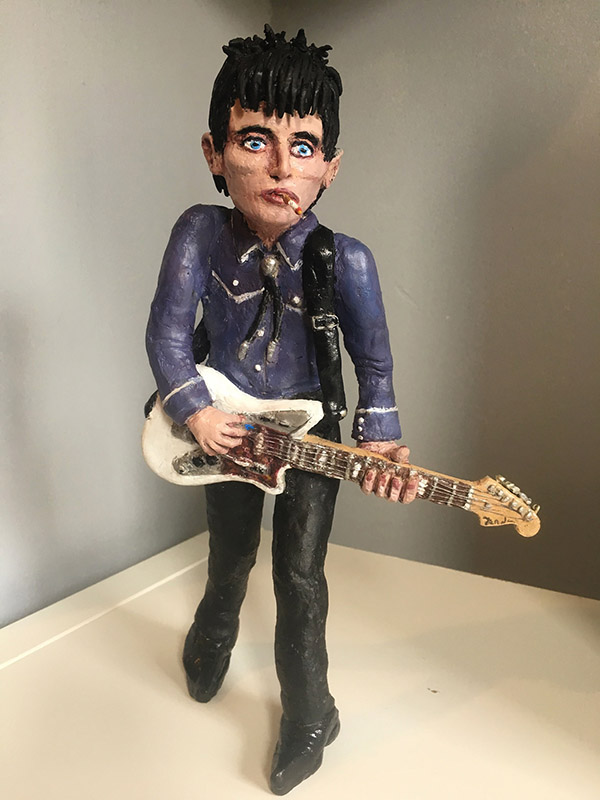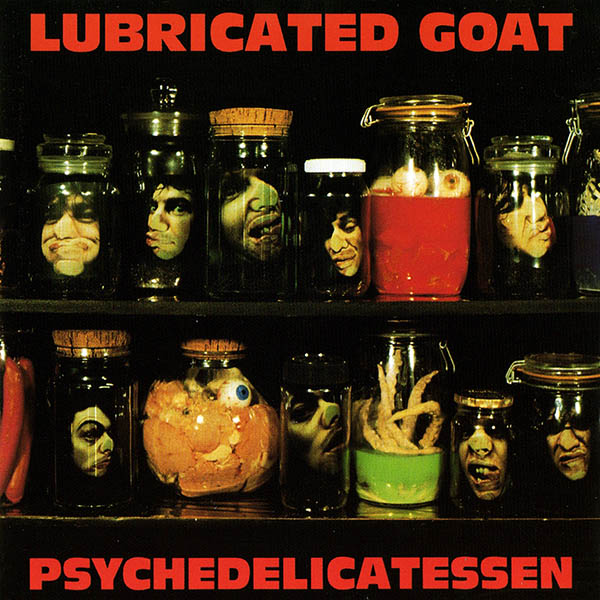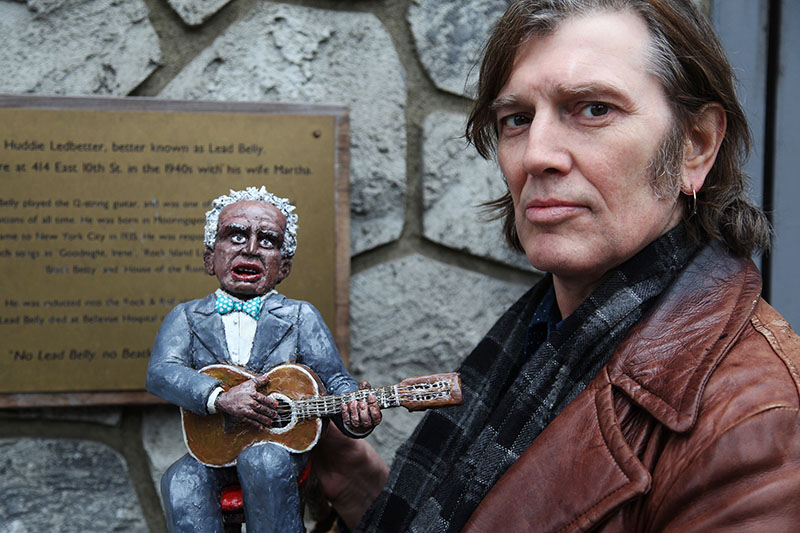Tell us about your artistic background.
I don’t really have an artistic background other than what I do myself. They didn’t teach me about art at my school, I just sat in the corner and drew pictures. I wish that someone had taught me how to draw and paint better.
I wish I’d gone to art school. I remember when I was a kid, reading articles about bands like the Rolling Stones or Led Zeppelin, and they would always say they went to art school. I was like: what the fuck is art school? I didn’t know there was such a thing; my parents didn’t tell me that there was. They told me, “You can quit school and get a shit job,” they didn’t tell me there was this thing called art school.
What do you think art school would have given you that you don’t already have?
Well, later on when I moved from Adelaide to Melbourne, I used to go to art schools that friends of mine went to, like Prahran Art School, and just hang around there and they’d give me an easel and a canvas to paint on. I’m sure that I had enough innate ability that I could’ve gone to an art school if someone had fuckin’ told me that the opportunity existed. But some artists that I know have said: “It’s good [that you aren’t formally trained] because then your own style comes out.”
And everything that I do artistically, sculpting or painting, you can automatically tell that I did it. That’s because it’s got a certain wonky quality, which I like. The only time it’s a problem is when I try to do something that’s graphically perfect because it’s lacking in the basics that anybody is taught, if they’re taught properly. One of my problems is I try to do things too detailed using my lacking skills, and then they become very clear. So I’ve found it’s better to do things kinda slapdash and not try to make it too fancy; that’s when it suits it and my humour comes through or whatever.
 Rowland S. Howard.
Rowland S. Howard.
You did a fair bit of artwork for Lubricated Goat in the ’80s – was that your first opportunity to do art that the public might have seen?
I would draw posters for our shows and then photocopy them and put them around. That was good fun. That was back in the days when you were allowed to go ’round sticking posters up on walls. I still enjoy drawing flyers, but flyers rarely exist in paper form anymore – someone creates it on a computer and puts it on Facebook.
When it came to the cover art for the first Lubricated Goat record ("…Plays The Devil’s Music", 1987], I was trying to emulate 15th century woodcut-type art, like pictures of the devil from that era. Because the lettering was sort of gothic style and because it was hand-done, it had that wonky quality that stuff had in the 15th century. Y’know, it didn’t have graphic perfection, and I think that suited that album very well – it looks kind of cartoonish, but it also has that 15th century Satanic art look about it.

And then I did the cover for the second record (Paddock Of Love, 1988] as well, and then by the time we did the third record ["Schadenfreude", 1989], although I did the lettering, I was like: “I shouldn’t just fuckin’ sit there and literally draw everything; there are other people that could be utilised.” Then by the time we came to "Psychedelicatessen" [1990] I didn’t draw the cover but I came up with the photographic concept, which was the members’ faces pressed against glass and put inside jars and made to look like we were on the shelves of a “psychedelicatessen”.
I assembled this installation and photographed it and it was a really great piece of art, I think. In fact, the cover is way better than the record itself. Mainly because we didn’t have enough time to produce the record the way that I wanted to, but that’s getting into music and not art. Anyway, I gradually shied away from hand-drawing everything. This was well before the days of computers being accessible, and even now I’m not very good with Photoshop.

You are pretty good with clay, though. Or, what are your sculptures made from?
They’re made out of a two-part epoxy putty, it’s like a clay – or one part is more like a clay than the other. When I lived in Australia I used to make them out of this stuff called Das, which was an air-hardening clay. It probably wasn’t the best thing to use. And then for a long time here I used to make them out of Sculpey, which is a good substance to sculpt with but it doesn’t dry, or you have to put it in an oven to get it to set. It looks really nice but it’s not very strong. So maybe four years ago I discovered this Smooth-On epoxy putty. Like I said, it’s a two-part putty and it’s air-drying. It’s great for sculpting, takes details really well, and it’s also very durable – it’s heavy and solid and strong.
 The Coop.
The Coop.
The "New York Hustle" documentary shows you working on a sculpture of Leadbelly. How do you think he turned out?
This is the best Leadbelly I can make. I’m usually satisfied with the end result, but the recurring theme generally is that I should have got paid more because it takes a long time to make a sculpture like Leadbelly. If it was someone that didn’t really exist it wouldn’t take as long but because it’s someone that exists, and because I’m not that familiar with Leadbelly’s face, I had to keep looking at pictures of him and keep adapting it, like, his eyes are not right or his nose or whatever.
How difficult is the art hustle in New York?
It’s hard but I really don’t spend enough time doing it. I’ve had exhibitions in galleries but it’s kind of repulsive – there are probably bigger wankers in the art world than in music or just about anything else. I’ve never really taken it as seriously as I should, and that might be because I was never encouraged as an artist. It’s obvious, and especially with the younger generation, there’s a lot of people, probably because they had hippie parents or whatever, everything that their child did was brilliant and they stuck it on the fridge.
My parents never stuck anything I did on the fridge. They weren’t fine art collectors by any means, but they certainly weren’t very encouraging for whatever reason. And yet my pictures were certainly as worthy of going on the fridge as most children’s. Even though they didn’t teach me anything, they would knock my natural talent, if there was such a thing. They’d say, “Oh, the light is coming from the wrong direction,” or whatever. I did a painting for my mum for her birthday once and my dad criticised it for its lack of artistic merit. It’s like, well you could’ve fuckin’ sent me to an art school, you didn’t even tell me there was such a thing! Then you’ve got the audacity to criticise my art over simple things that could easily be rectified with a decent education!


